International Business Strategies of Uber: A Comprehensive Analysis
VerifiedAdded on 2023/04/22
|19
|4150
|238
Report
AI Summary
This report provides a comprehensive analysis of Uber's business strategies, focusing on the challenges and opportunities it faces, particularly in the United States. It begins with an executive summary and a table of contents, setting the stage for a detailed examination. The report employs various strategic models, including PESTLE analysis, Porter's Five Forces, value chain analysis, SWOT analysis, and TOWS matrix, to evaluate Uber's internal and external environments. It also utilizes the Ansoff matrix to recommend strategies and discusses the integration responsiveness framework to assess Uber's market responsiveness. Furthermore, the report identifies Uber's market entry strategies in India and China, concluding that Uber has adopted a licensing entry mode strategy in these countries. The report covers political, economic, social, technological, legal, and environmental factors affecting Uber's operations. It also analyzes the bargaining power of customers and suppliers, threats of new entrants and substitutes, and Uber's value chain. The SWOT analysis highlights strengths, weaknesses, opportunities, and threats, while the TOWS matrix suggests potential actions. The Ansoff matrix identifies strategies for these actions, and the integration responsiveness framework assesses Uber's market responsiveness outside the US. The report concludes by identifying Uber's market entry strategies in India and China, indicating a licensing entry mode strategy.
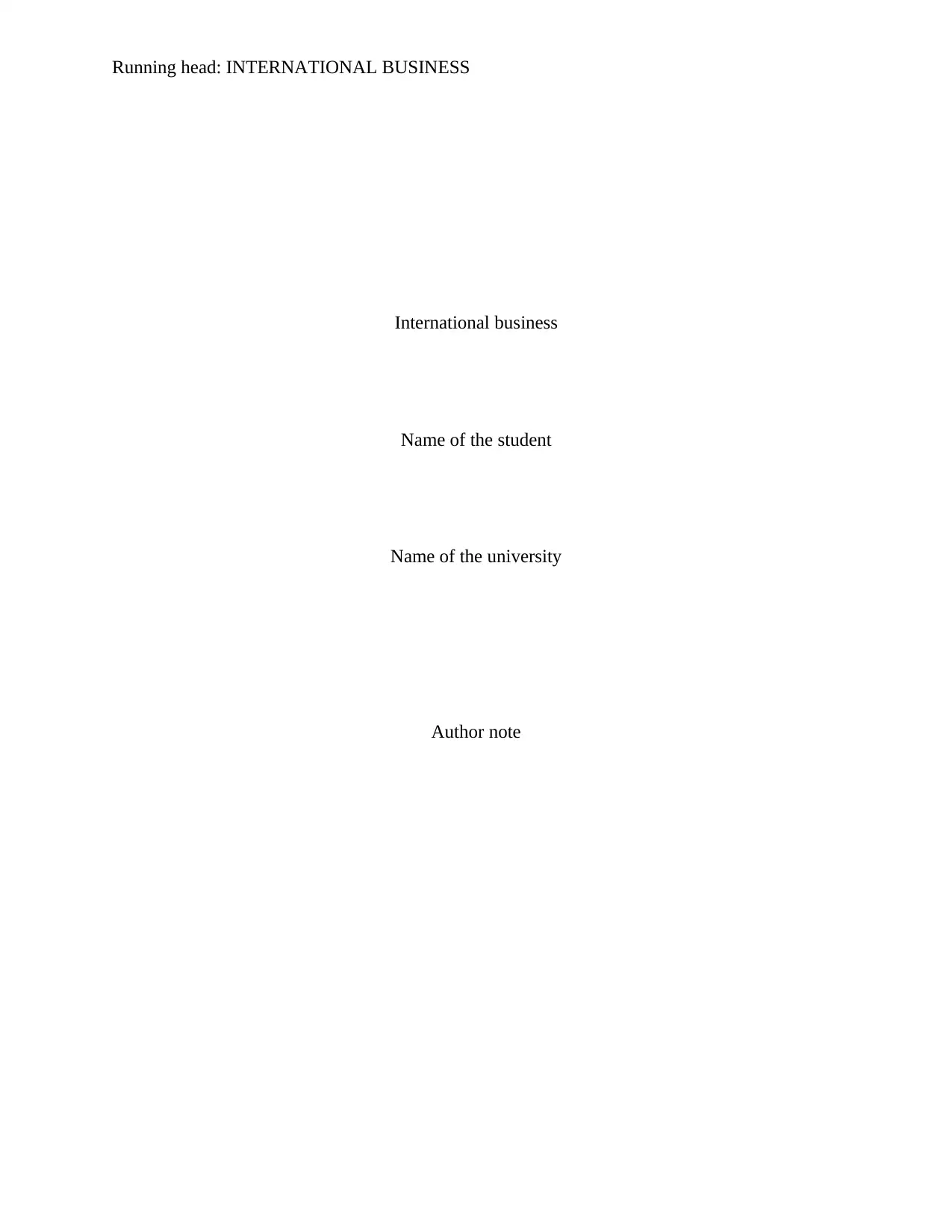
Running head: INTERNATIONAL BUSINESS
International business
Name of the student
Name of the university
Author note
International business
Name of the student
Name of the university
Author note
Paraphrase This Document
Need a fresh take? Get an instant paraphrase of this document with our AI Paraphraser
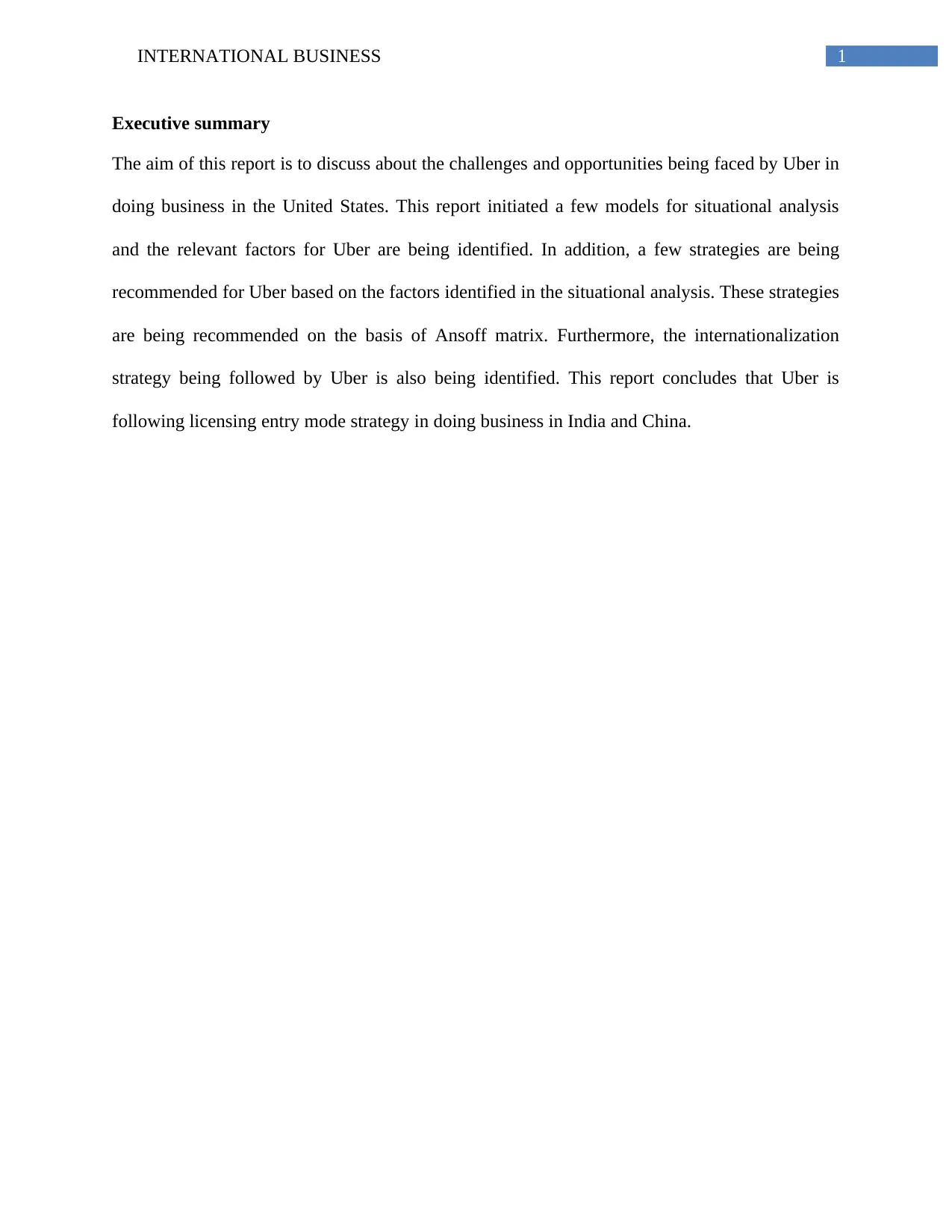
1INTERNATIONAL BUSINESS
Executive summary
The aim of this report is to discuss about the challenges and opportunities being faced by Uber in
doing business in the United States. This report initiated a few models for situational analysis
and the relevant factors for Uber are being identified. In addition, a few strategies are being
recommended for Uber based on the factors identified in the situational analysis. These strategies
are being recommended on the basis of Ansoff matrix. Furthermore, the internationalization
strategy being followed by Uber is also being identified. This report concludes that Uber is
following licensing entry mode strategy in doing business in India and China.
Executive summary
The aim of this report is to discuss about the challenges and opportunities being faced by Uber in
doing business in the United States. This report initiated a few models for situational analysis
and the relevant factors for Uber are being identified. In addition, a few strategies are being
recommended for Uber based on the factors identified in the situational analysis. These strategies
are being recommended on the basis of Ansoff matrix. Furthermore, the internationalization
strategy being followed by Uber is also being identified. This report concludes that Uber is
following licensing entry mode strategy in doing business in India and China.
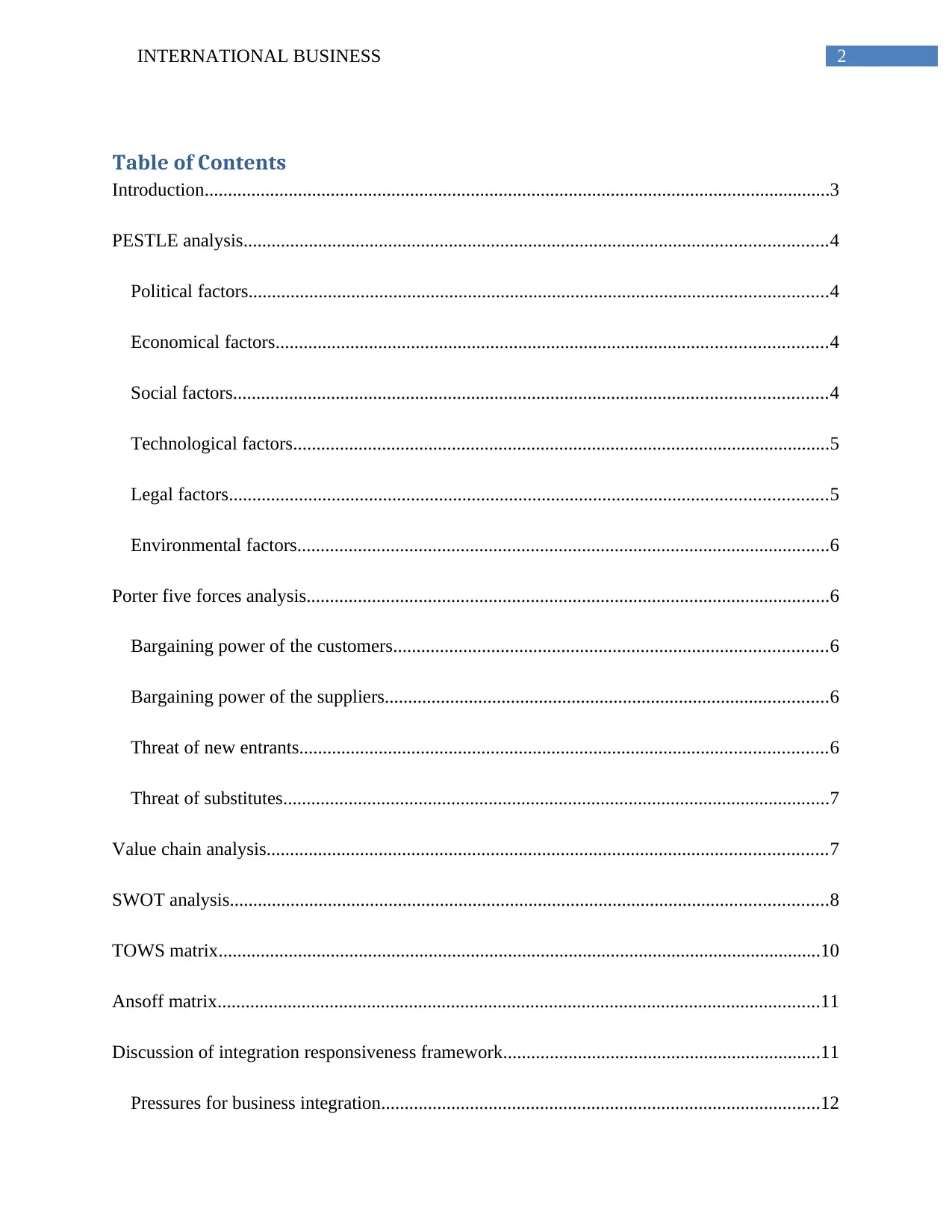
2INTERNATIONAL BUSINESS
Table of Contents
Introduction......................................................................................................................................3
PESTLE analysis.............................................................................................................................4
Political factors............................................................................................................................4
Economical factors......................................................................................................................4
Social factors...............................................................................................................................4
Technological factors...................................................................................................................5
Legal factors................................................................................................................................5
Environmental factors..................................................................................................................6
Porter five forces analysis................................................................................................................6
Bargaining power of the customers.............................................................................................6
Bargaining power of the suppliers...............................................................................................6
Threat of new entrants.................................................................................................................6
Threat of substitutes.....................................................................................................................7
Value chain analysis........................................................................................................................7
SWOT analysis................................................................................................................................8
TOWS matrix.................................................................................................................................10
Ansoff matrix.................................................................................................................................11
Discussion of integration responsiveness framework....................................................................11
Pressures for business integration..............................................................................................12
Table of Contents
Introduction......................................................................................................................................3
PESTLE analysis.............................................................................................................................4
Political factors............................................................................................................................4
Economical factors......................................................................................................................4
Social factors...............................................................................................................................4
Technological factors...................................................................................................................5
Legal factors................................................................................................................................5
Environmental factors..................................................................................................................6
Porter five forces analysis................................................................................................................6
Bargaining power of the customers.............................................................................................6
Bargaining power of the suppliers...............................................................................................6
Threat of new entrants.................................................................................................................6
Threat of substitutes.....................................................................................................................7
Value chain analysis........................................................................................................................7
SWOT analysis................................................................................................................................8
TOWS matrix.................................................................................................................................10
Ansoff matrix.................................................................................................................................11
Discussion of integration responsiveness framework....................................................................11
Pressures for business integration..............................................................................................12
⊘ This is a preview!⊘
Do you want full access?
Subscribe today to unlock all pages.

Trusted by 1+ million students worldwide
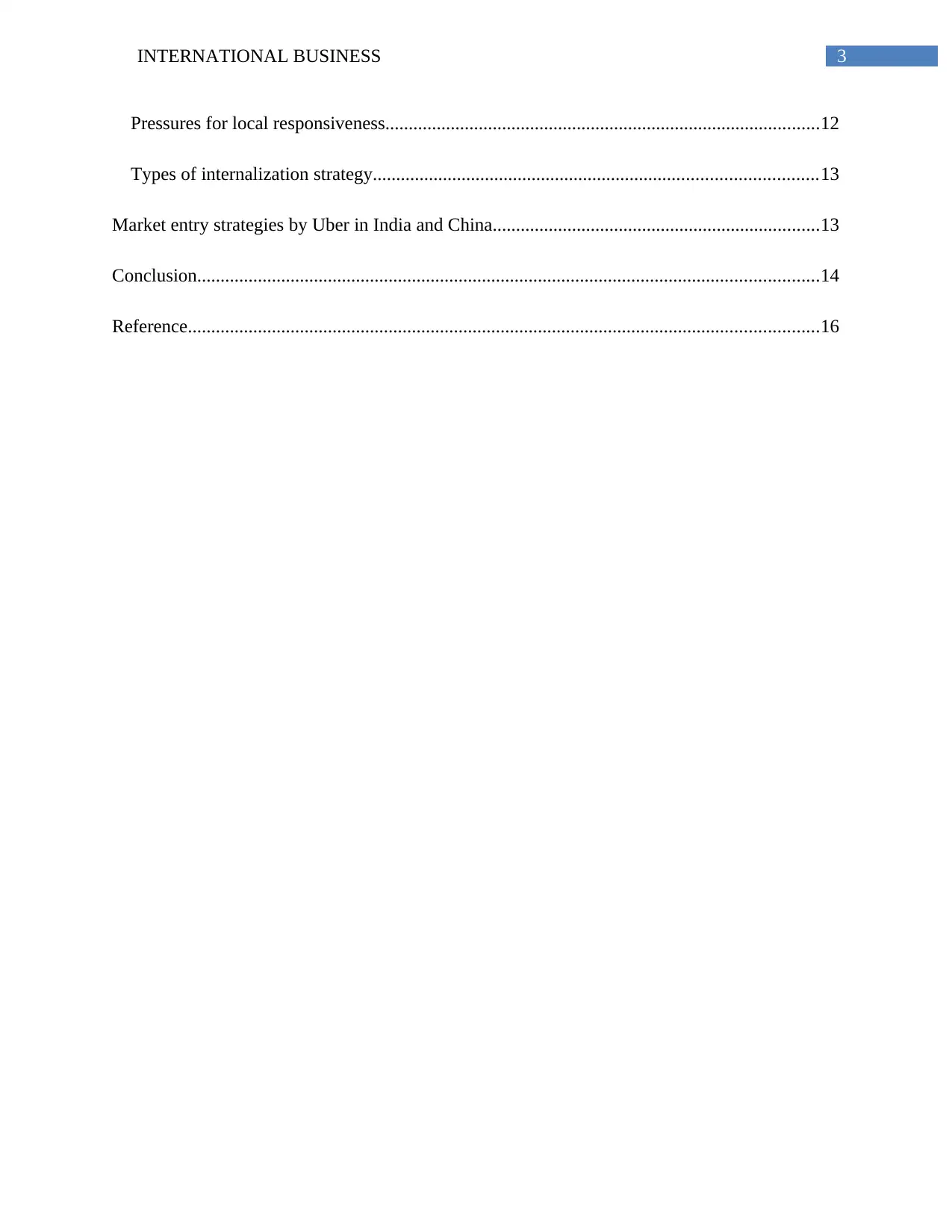
3INTERNATIONAL BUSINESS
Pressures for local responsiveness.............................................................................................12
Types of internalization strategy...............................................................................................13
Market entry strategies by Uber in India and China......................................................................13
Conclusion.....................................................................................................................................14
Reference.......................................................................................................................................16
Pressures for local responsiveness.............................................................................................12
Types of internalization strategy...............................................................................................13
Market entry strategies by Uber in India and China......................................................................13
Conclusion.....................................................................................................................................14
Reference.......................................................................................................................................16
Paraphrase This Document
Need a fresh take? Get an instant paraphrase of this document with our AI Paraphraser
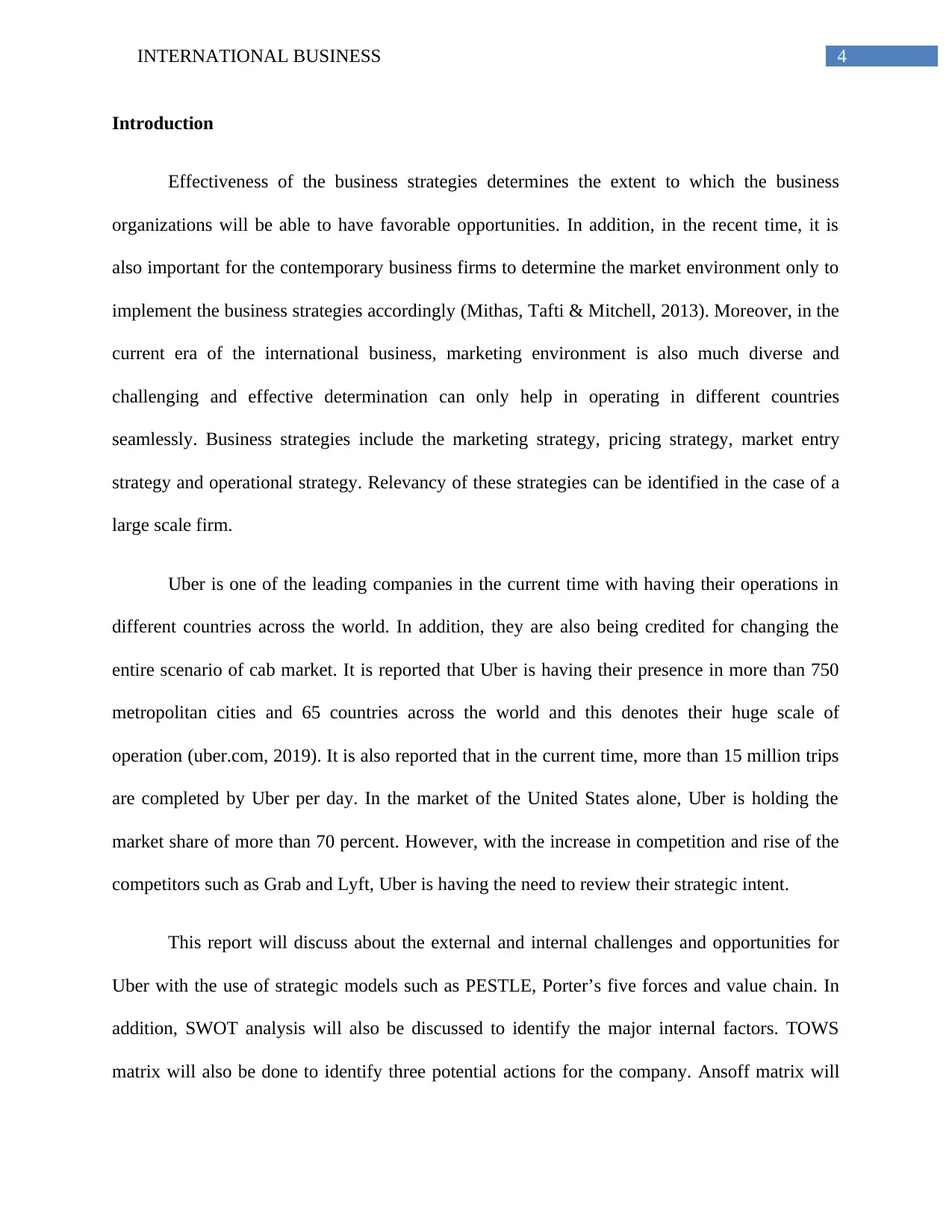
4INTERNATIONAL BUSINESS
Introduction
Effectiveness of the business strategies determines the extent to which the business
organizations will be able to have favorable opportunities. In addition, in the recent time, it is
also important for the contemporary business firms to determine the market environment only to
implement the business strategies accordingly (Mithas, Tafti & Mitchell, 2013). Moreover, in the
current era of the international business, marketing environment is also much diverse and
challenging and effective determination can only help in operating in different countries
seamlessly. Business strategies include the marketing strategy, pricing strategy, market entry
strategy and operational strategy. Relevancy of these strategies can be identified in the case of a
large scale firm.
Uber is one of the leading companies in the current time with having their operations in
different countries across the world. In addition, they are also being credited for changing the
entire scenario of cab market. It is reported that Uber is having their presence in more than 750
metropolitan cities and 65 countries across the world and this denotes their huge scale of
operation (uber.com, 2019). It is also reported that in the current time, more than 15 million trips
are completed by Uber per day. In the market of the United States alone, Uber is holding the
market share of more than 70 percent. However, with the increase in competition and rise of the
competitors such as Grab and Lyft, Uber is having the need to review their strategic intent.
This report will discuss about the external and internal challenges and opportunities for
Uber with the use of strategic models such as PESTLE, Porter’s five forces and value chain. In
addition, SWOT analysis will also be discussed to identify the major internal factors. TOWS
matrix will also be done to identify three potential actions for the company. Ansoff matrix will
Introduction
Effectiveness of the business strategies determines the extent to which the business
organizations will be able to have favorable opportunities. In addition, in the recent time, it is
also important for the contemporary business firms to determine the market environment only to
implement the business strategies accordingly (Mithas, Tafti & Mitchell, 2013). Moreover, in the
current era of the international business, marketing environment is also much diverse and
challenging and effective determination can only help in operating in different countries
seamlessly. Business strategies include the marketing strategy, pricing strategy, market entry
strategy and operational strategy. Relevancy of these strategies can be identified in the case of a
large scale firm.
Uber is one of the leading companies in the current time with having their operations in
different countries across the world. In addition, they are also being credited for changing the
entire scenario of cab market. It is reported that Uber is having their presence in more than 750
metropolitan cities and 65 countries across the world and this denotes their huge scale of
operation (uber.com, 2019). It is also reported that in the current time, more than 15 million trips
are completed by Uber per day. In the market of the United States alone, Uber is holding the
market share of more than 70 percent. However, with the increase in competition and rise of the
competitors such as Grab and Lyft, Uber is having the need to review their strategic intent.
This report will discuss about the external and internal challenges and opportunities for
Uber with the use of strategic models such as PESTLE, Porter’s five forces and value chain. In
addition, SWOT analysis will also be discussed to identify the major internal factors. TOWS
matrix will also be done to identify three potential actions for the company. Ansoff matrix will
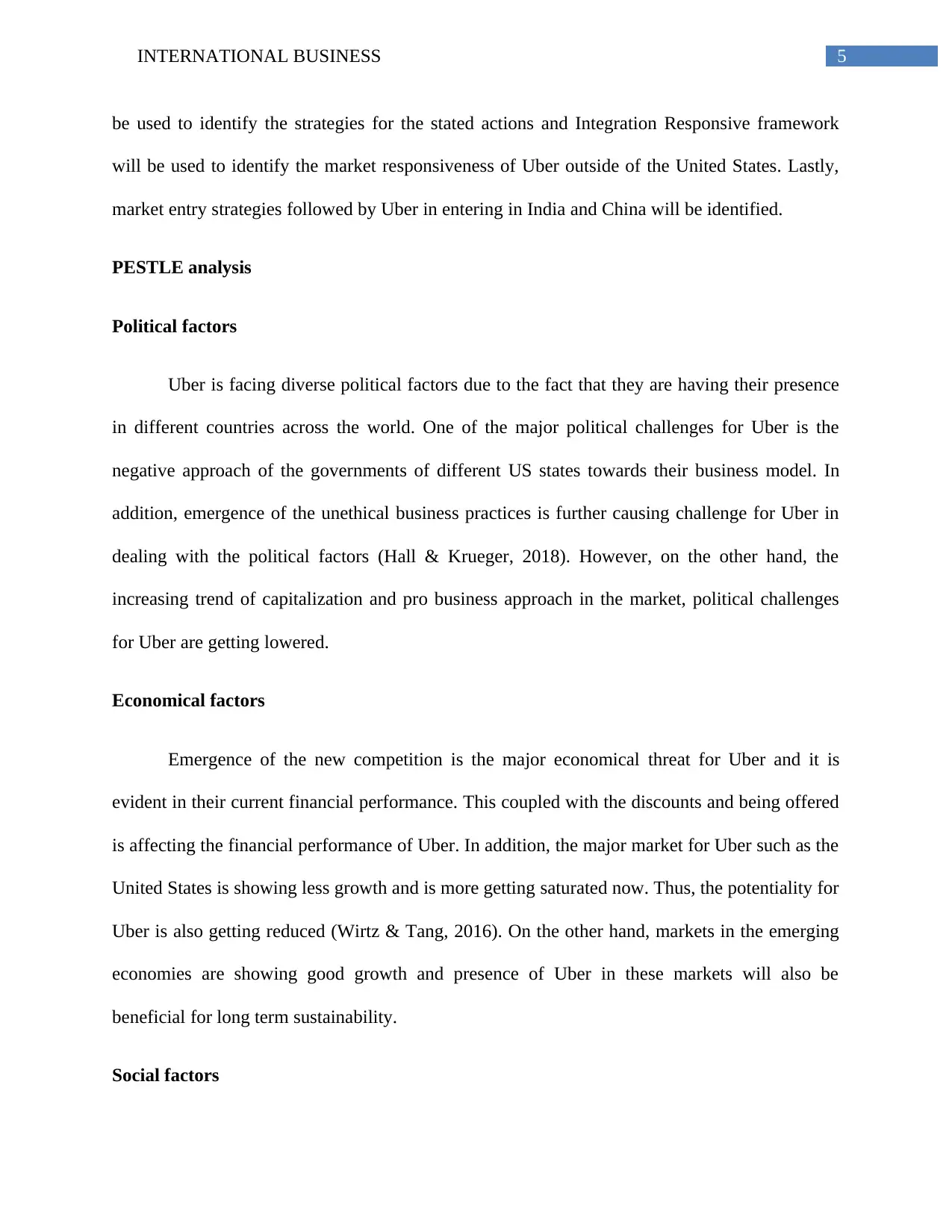
5INTERNATIONAL BUSINESS
be used to identify the strategies for the stated actions and Integration Responsive framework
will be used to identify the market responsiveness of Uber outside of the United States. Lastly,
market entry strategies followed by Uber in entering in India and China will be identified.
PESTLE analysis
Political factors
Uber is facing diverse political factors due to the fact that they are having their presence
in different countries across the world. One of the major political challenges for Uber is the
negative approach of the governments of different US states towards their business model. In
addition, emergence of the unethical business practices is further causing challenge for Uber in
dealing with the political factors (Hall & Krueger, 2018). However, on the other hand, the
increasing trend of capitalization and pro business approach in the market, political challenges
for Uber are getting lowered.
Economical factors
Emergence of the new competition is the major economical threat for Uber and it is
evident in their current financial performance. This coupled with the discounts and being offered
is affecting the financial performance of Uber. In addition, the major market for Uber such as the
United States is showing less growth and is more getting saturated now. Thus, the potentiality for
Uber is also getting reduced (Wirtz & Tang, 2016). On the other hand, markets in the emerging
economies are showing good growth and presence of Uber in these markets will also be
beneficial for long term sustainability.
Social factors
be used to identify the strategies for the stated actions and Integration Responsive framework
will be used to identify the market responsiveness of Uber outside of the United States. Lastly,
market entry strategies followed by Uber in entering in India and China will be identified.
PESTLE analysis
Political factors
Uber is facing diverse political factors due to the fact that they are having their presence
in different countries across the world. One of the major political challenges for Uber is the
negative approach of the governments of different US states towards their business model. In
addition, emergence of the unethical business practices is further causing challenge for Uber in
dealing with the political factors (Hall & Krueger, 2018). However, on the other hand, the
increasing trend of capitalization and pro business approach in the market, political challenges
for Uber are getting lowered.
Economical factors
Emergence of the new competition is the major economical threat for Uber and it is
evident in their current financial performance. This coupled with the discounts and being offered
is affecting the financial performance of Uber. In addition, the major market for Uber such as the
United States is showing less growth and is more getting saturated now. Thus, the potentiality for
Uber is also getting reduced (Wirtz & Tang, 2016). On the other hand, markets in the emerging
economies are showing good growth and presence of Uber in these markets will also be
beneficial for long term sustainability.
Social factors
⊘ This is a preview!⊘
Do you want full access?
Subscribe today to unlock all pages.

Trusted by 1+ million students worldwide
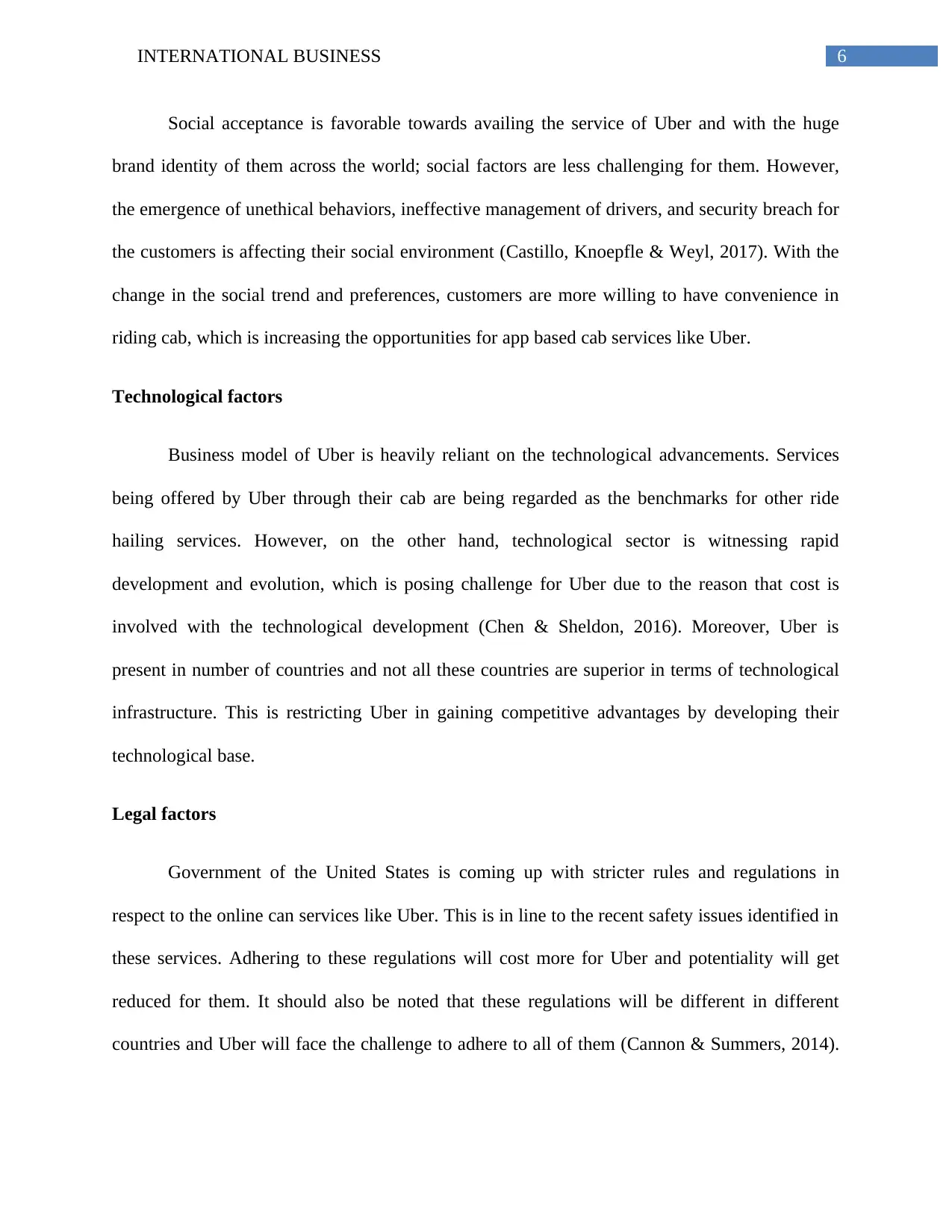
6INTERNATIONAL BUSINESS
Social acceptance is favorable towards availing the service of Uber and with the huge
brand identity of them across the world; social factors are less challenging for them. However,
the emergence of unethical behaviors, ineffective management of drivers, and security breach for
the customers is affecting their social environment (Castillo, Knoepfle & Weyl, 2017). With the
change in the social trend and preferences, customers are more willing to have convenience in
riding cab, which is increasing the opportunities for app based cab services like Uber.
Technological factors
Business model of Uber is heavily reliant on the technological advancements. Services
being offered by Uber through their cab are being regarded as the benchmarks for other ride
hailing services. However, on the other hand, technological sector is witnessing rapid
development and evolution, which is posing challenge for Uber due to the reason that cost is
involved with the technological development (Chen & Sheldon, 2016). Moreover, Uber is
present in number of countries and not all these countries are superior in terms of technological
infrastructure. This is restricting Uber in gaining competitive advantages by developing their
technological base.
Legal factors
Government of the United States is coming up with stricter rules and regulations in
respect to the online can services like Uber. This is in line to the recent safety issues identified in
these services. Adhering to these regulations will cost more for Uber and potentiality will get
reduced for them. It should also be noted that these regulations will be different in different
countries and Uber will face the challenge to adhere to all of them (Cannon & Summers, 2014).
Social acceptance is favorable towards availing the service of Uber and with the huge
brand identity of them across the world; social factors are less challenging for them. However,
the emergence of unethical behaviors, ineffective management of drivers, and security breach for
the customers is affecting their social environment (Castillo, Knoepfle & Weyl, 2017). With the
change in the social trend and preferences, customers are more willing to have convenience in
riding cab, which is increasing the opportunities for app based cab services like Uber.
Technological factors
Business model of Uber is heavily reliant on the technological advancements. Services
being offered by Uber through their cab are being regarded as the benchmarks for other ride
hailing services. However, on the other hand, technological sector is witnessing rapid
development and evolution, which is posing challenge for Uber due to the reason that cost is
involved with the technological development (Chen & Sheldon, 2016). Moreover, Uber is
present in number of countries and not all these countries are superior in terms of technological
infrastructure. This is restricting Uber in gaining competitive advantages by developing their
technological base.
Legal factors
Government of the United States is coming up with stricter rules and regulations in
respect to the online can services like Uber. This is in line to the recent safety issues identified in
these services. Adhering to these regulations will cost more for Uber and potentiality will get
reduced for them. It should also be noted that these regulations will be different in different
countries and Uber will face the challenge to adhere to all of them (Cannon & Summers, 2014).
Paraphrase This Document
Need a fresh take? Get an instant paraphrase of this document with our AI Paraphraser
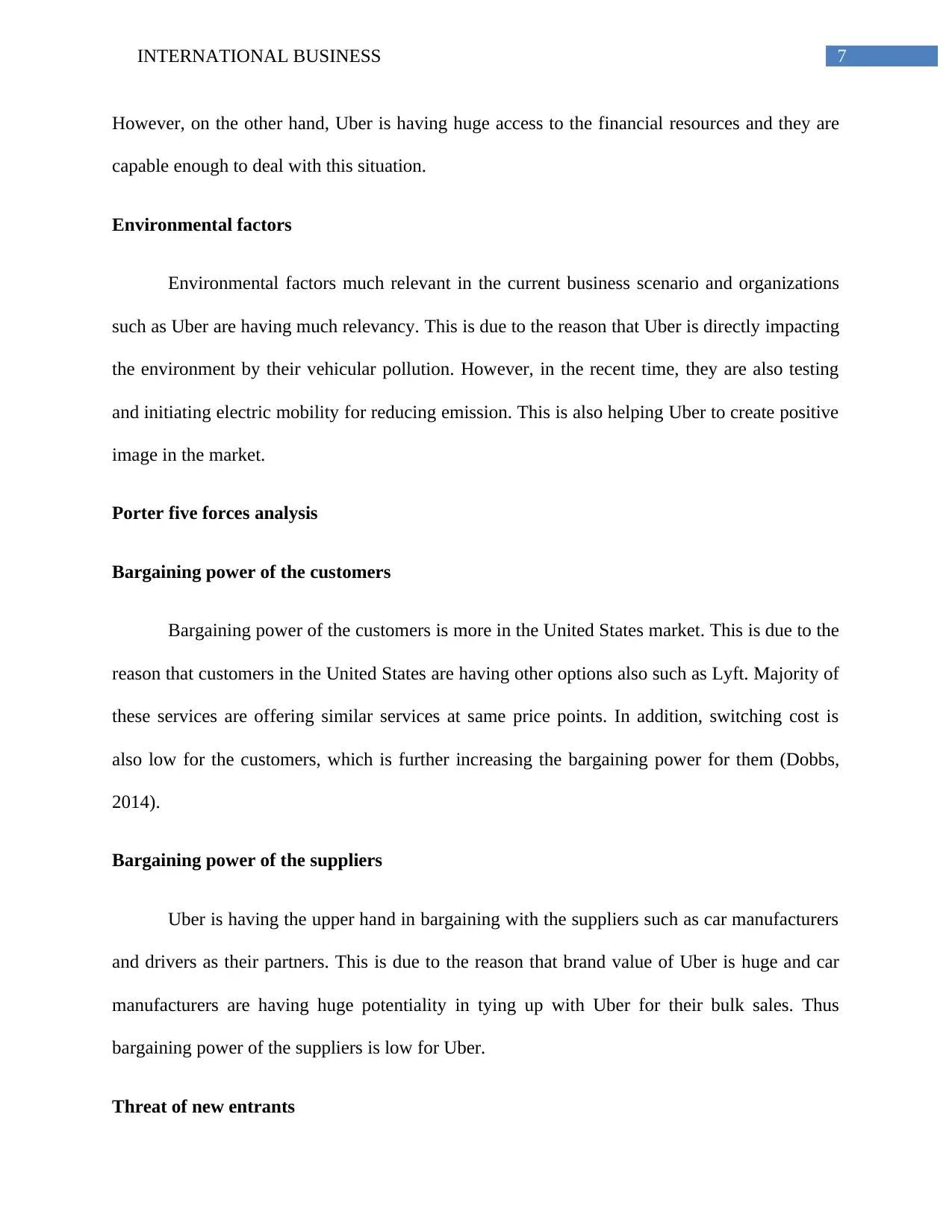
7INTERNATIONAL BUSINESS
However, on the other hand, Uber is having huge access to the financial resources and they are
capable enough to deal with this situation.
Environmental factors
Environmental factors much relevant in the current business scenario and organizations
such as Uber are having much relevancy. This is due to the reason that Uber is directly impacting
the environment by their vehicular pollution. However, in the recent time, they are also testing
and initiating electric mobility for reducing emission. This is also helping Uber to create positive
image in the market.
Porter five forces analysis
Bargaining power of the customers
Bargaining power of the customers is more in the United States market. This is due to the
reason that customers in the United States are having other options also such as Lyft. Majority of
these services are offering similar services at same price points. In addition, switching cost is
also low for the customers, which is further increasing the bargaining power for them (Dobbs,
2014).
Bargaining power of the suppliers
Uber is having the upper hand in bargaining with the suppliers such as car manufacturers
and drivers as their partners. This is due to the reason that brand value of Uber is huge and car
manufacturers are having huge potentiality in tying up with Uber for their bulk sales. Thus
bargaining power of the suppliers is low for Uber.
Threat of new entrants
However, on the other hand, Uber is having huge access to the financial resources and they are
capable enough to deal with this situation.
Environmental factors
Environmental factors much relevant in the current business scenario and organizations
such as Uber are having much relevancy. This is due to the reason that Uber is directly impacting
the environment by their vehicular pollution. However, in the recent time, they are also testing
and initiating electric mobility for reducing emission. This is also helping Uber to create positive
image in the market.
Porter five forces analysis
Bargaining power of the customers
Bargaining power of the customers is more in the United States market. This is due to the
reason that customers in the United States are having other options also such as Lyft. Majority of
these services are offering similar services at same price points. In addition, switching cost is
also low for the customers, which is further increasing the bargaining power for them (Dobbs,
2014).
Bargaining power of the suppliers
Uber is having the upper hand in bargaining with the suppliers such as car manufacturers
and drivers as their partners. This is due to the reason that brand value of Uber is huge and car
manufacturers are having huge potentiality in tying up with Uber for their bulk sales. Thus
bargaining power of the suppliers is low for Uber.
Threat of new entrants
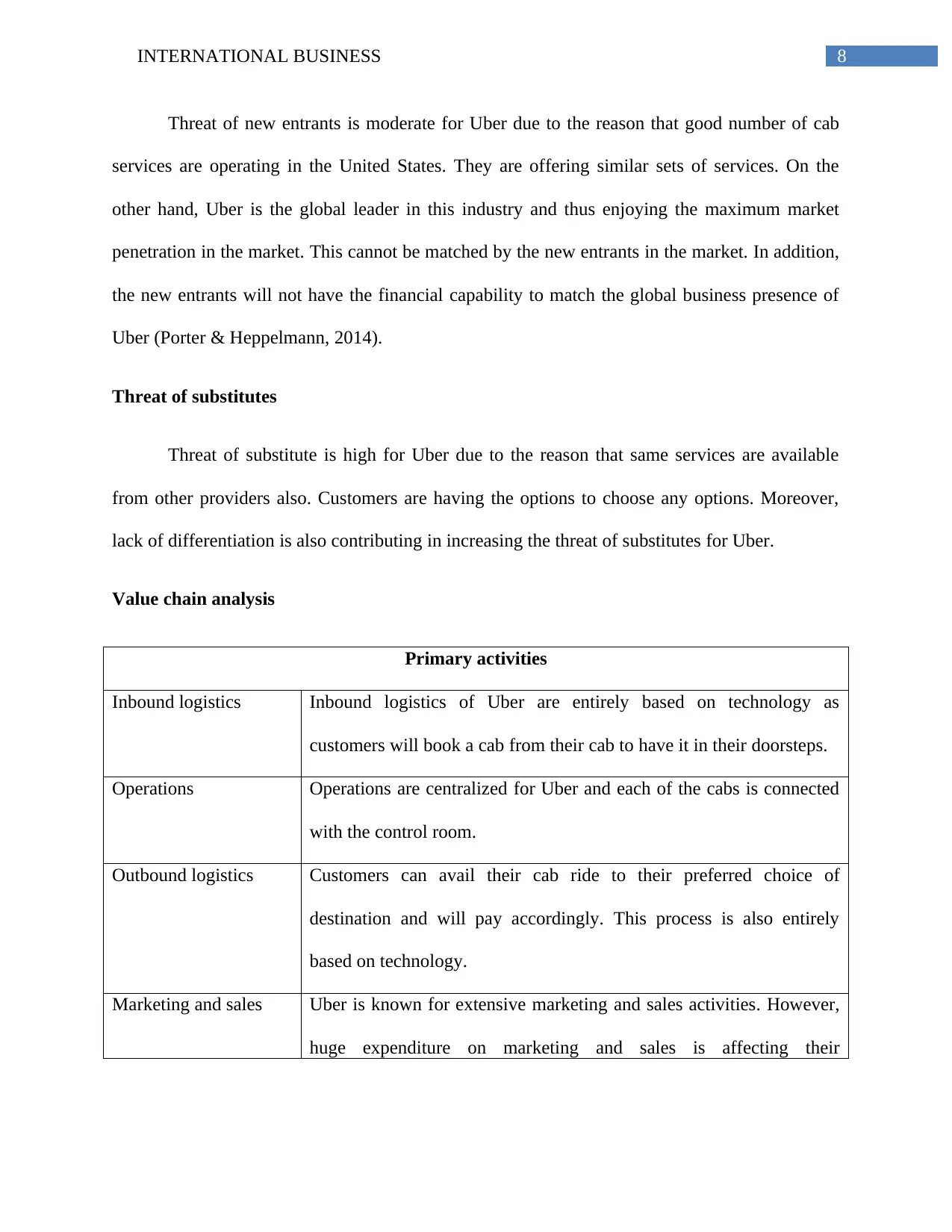
8INTERNATIONAL BUSINESS
Threat of new entrants is moderate for Uber due to the reason that good number of cab
services are operating in the United States. They are offering similar sets of services. On the
other hand, Uber is the global leader in this industry and thus enjoying the maximum market
penetration in the market. This cannot be matched by the new entrants in the market. In addition,
the new entrants will not have the financial capability to match the global business presence of
Uber (Porter & Heppelmann, 2014).
Threat of substitutes
Threat of substitute is high for Uber due to the reason that same services are available
from other providers also. Customers are having the options to choose any options. Moreover,
lack of differentiation is also contributing in increasing the threat of substitutes for Uber.
Value chain analysis
Primary activities
Inbound logistics Inbound logistics of Uber are entirely based on technology as
customers will book a cab from their cab to have it in their doorsteps.
Operations Operations are centralized for Uber and each of the cabs is connected
with the control room.
Outbound logistics Customers can avail their cab ride to their preferred choice of
destination and will pay accordingly. This process is also entirely
based on technology.
Marketing and sales Uber is known for extensive marketing and sales activities. However,
huge expenditure on marketing and sales is affecting their
Threat of new entrants is moderate for Uber due to the reason that good number of cab
services are operating in the United States. They are offering similar sets of services. On the
other hand, Uber is the global leader in this industry and thus enjoying the maximum market
penetration in the market. This cannot be matched by the new entrants in the market. In addition,
the new entrants will not have the financial capability to match the global business presence of
Uber (Porter & Heppelmann, 2014).
Threat of substitutes
Threat of substitute is high for Uber due to the reason that same services are available
from other providers also. Customers are having the options to choose any options. Moreover,
lack of differentiation is also contributing in increasing the threat of substitutes for Uber.
Value chain analysis
Primary activities
Inbound logistics Inbound logistics of Uber are entirely based on technology as
customers will book a cab from their cab to have it in their doorsteps.
Operations Operations are centralized for Uber and each of the cabs is connected
with the control room.
Outbound logistics Customers can avail their cab ride to their preferred choice of
destination and will pay accordingly. This process is also entirely
based on technology.
Marketing and sales Uber is known for extensive marketing and sales activities. However,
huge expenditure on marketing and sales is affecting their
⊘ This is a preview!⊘
Do you want full access?
Subscribe today to unlock all pages.

Trusted by 1+ million students worldwide
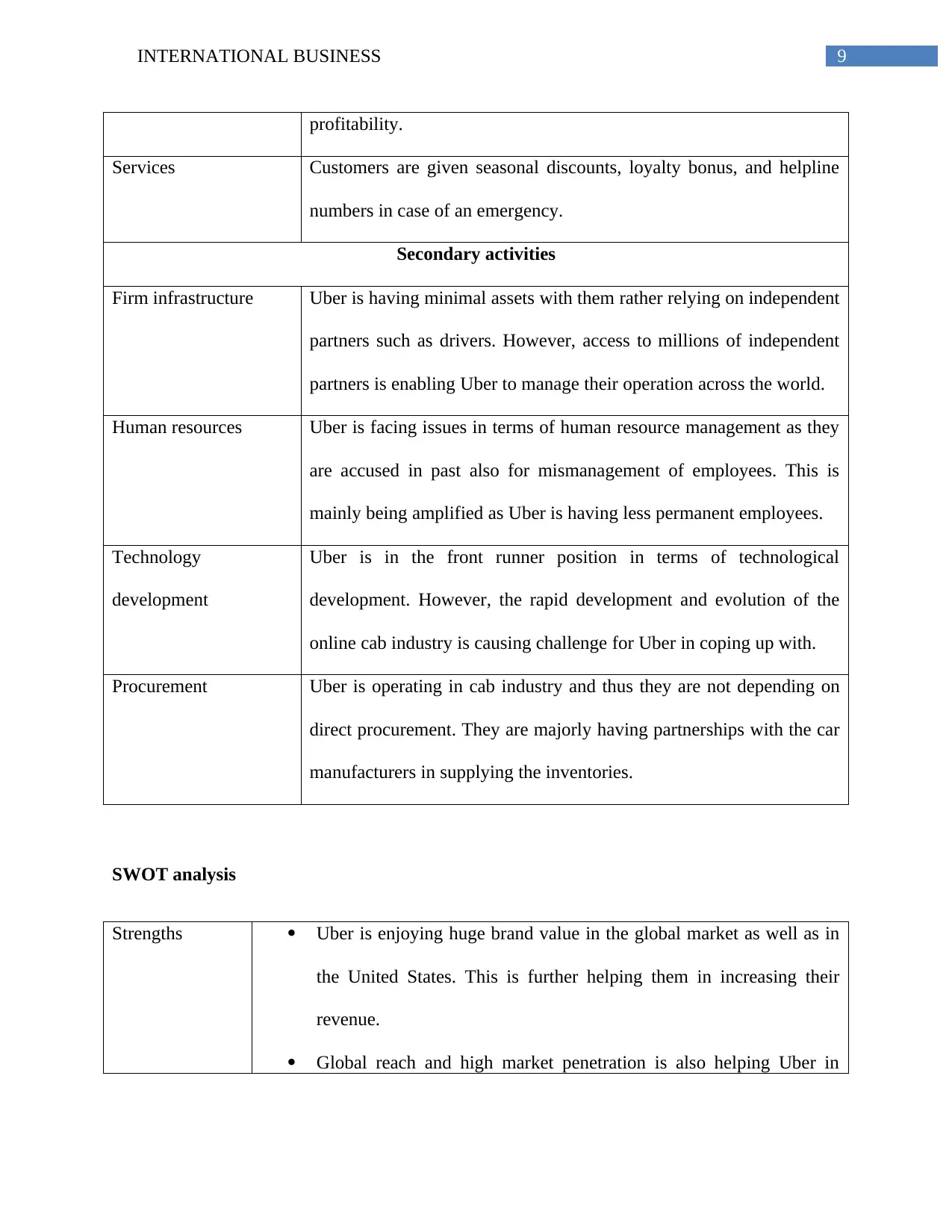
9INTERNATIONAL BUSINESS
profitability.
Services Customers are given seasonal discounts, loyalty bonus, and helpline
numbers in case of an emergency.
Secondary activities
Firm infrastructure Uber is having minimal assets with them rather relying on independent
partners such as drivers. However, access to millions of independent
partners is enabling Uber to manage their operation across the world.
Human resources Uber is facing issues in terms of human resource management as they
are accused in past also for mismanagement of employees. This is
mainly being amplified as Uber is having less permanent employees.
Technology
development
Uber is in the front runner position in terms of technological
development. However, the rapid development and evolution of the
online cab industry is causing challenge for Uber in coping up with.
Procurement Uber is operating in cab industry and thus they are not depending on
direct procurement. They are majorly having partnerships with the car
manufacturers in supplying the inventories.
SWOT analysis
Strengths Uber is enjoying huge brand value in the global market as well as in
the United States. This is further helping them in increasing their
revenue.
Global reach and high market penetration is also helping Uber in
profitability.
Services Customers are given seasonal discounts, loyalty bonus, and helpline
numbers in case of an emergency.
Secondary activities
Firm infrastructure Uber is having minimal assets with them rather relying on independent
partners such as drivers. However, access to millions of independent
partners is enabling Uber to manage their operation across the world.
Human resources Uber is facing issues in terms of human resource management as they
are accused in past also for mismanagement of employees. This is
mainly being amplified as Uber is having less permanent employees.
Technology
development
Uber is in the front runner position in terms of technological
development. However, the rapid development and evolution of the
online cab industry is causing challenge for Uber in coping up with.
Procurement Uber is operating in cab industry and thus they are not depending on
direct procurement. They are majorly having partnerships with the car
manufacturers in supplying the inventories.
SWOT analysis
Strengths Uber is enjoying huge brand value in the global market as well as in
the United States. This is further helping them in increasing their
revenue.
Global reach and high market penetration is also helping Uber in
Paraphrase This Document
Need a fresh take? Get an instant paraphrase of this document with our AI Paraphraser
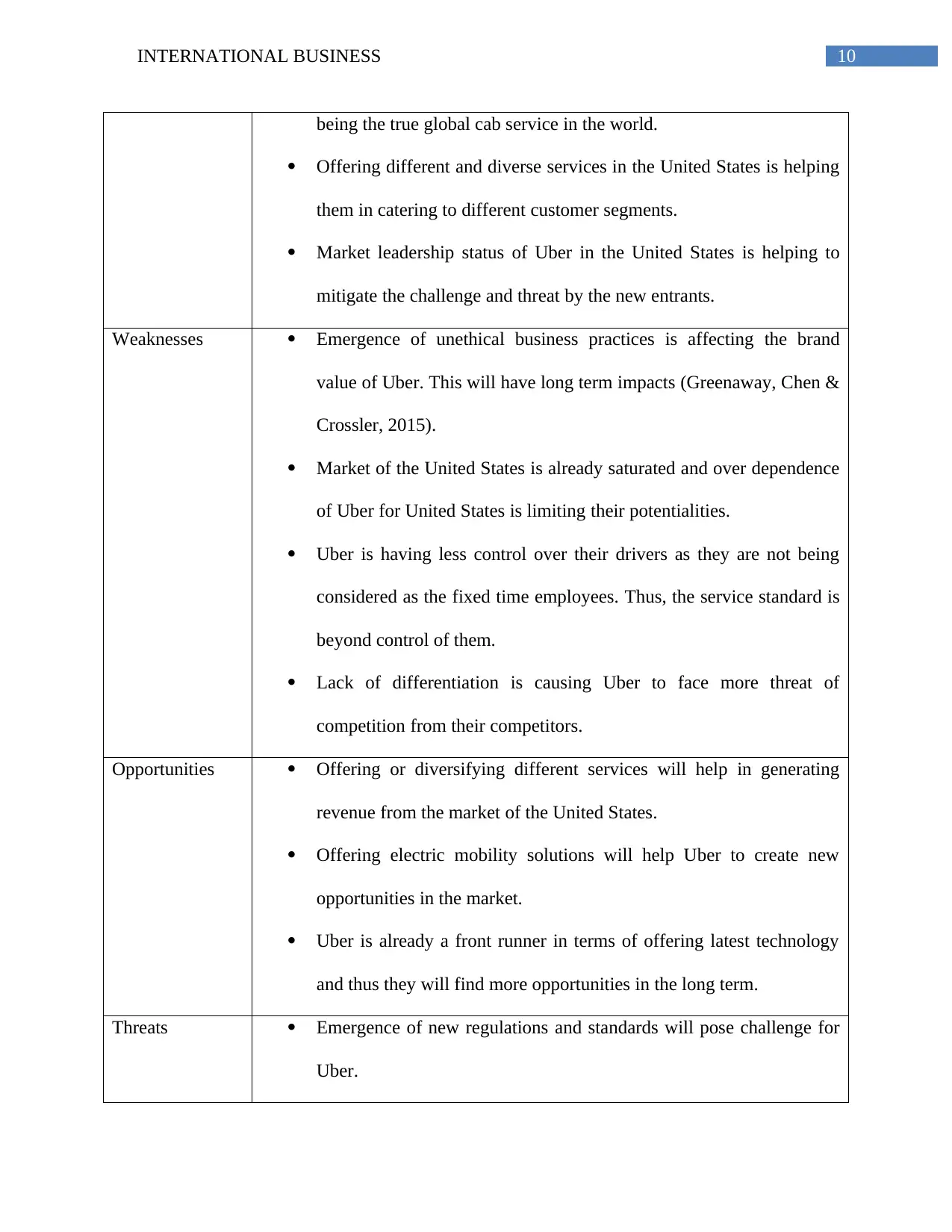
10INTERNATIONAL BUSINESS
being the true global cab service in the world.
Offering different and diverse services in the United States is helping
them in catering to different customer segments.
Market leadership status of Uber in the United States is helping to
mitigate the challenge and threat by the new entrants.
Weaknesses Emergence of unethical business practices is affecting the brand
value of Uber. This will have long term impacts (Greenaway, Chen &
Crossler, 2015).
Market of the United States is already saturated and over dependence
of Uber for United States is limiting their potentialities.
Uber is having less control over their drivers as they are not being
considered as the fixed time employees. Thus, the service standard is
beyond control of them.
Lack of differentiation is causing Uber to face more threat of
competition from their competitors.
Opportunities Offering or diversifying different services will help in generating
revenue from the market of the United States.
Offering electric mobility solutions will help Uber to create new
opportunities in the market.
Uber is already a front runner in terms of offering latest technology
and thus they will find more opportunities in the long term.
Threats Emergence of new regulations and standards will pose challenge for
Uber.
being the true global cab service in the world.
Offering different and diverse services in the United States is helping
them in catering to different customer segments.
Market leadership status of Uber in the United States is helping to
mitigate the challenge and threat by the new entrants.
Weaknesses Emergence of unethical business practices is affecting the brand
value of Uber. This will have long term impacts (Greenaway, Chen &
Crossler, 2015).
Market of the United States is already saturated and over dependence
of Uber for United States is limiting their potentialities.
Uber is having less control over their drivers as they are not being
considered as the fixed time employees. Thus, the service standard is
beyond control of them.
Lack of differentiation is causing Uber to face more threat of
competition from their competitors.
Opportunities Offering or diversifying different services will help in generating
revenue from the market of the United States.
Offering electric mobility solutions will help Uber to create new
opportunities in the market.
Uber is already a front runner in terms of offering latest technology
and thus they will find more opportunities in the long term.
Threats Emergence of new regulations and standards will pose challenge for
Uber.
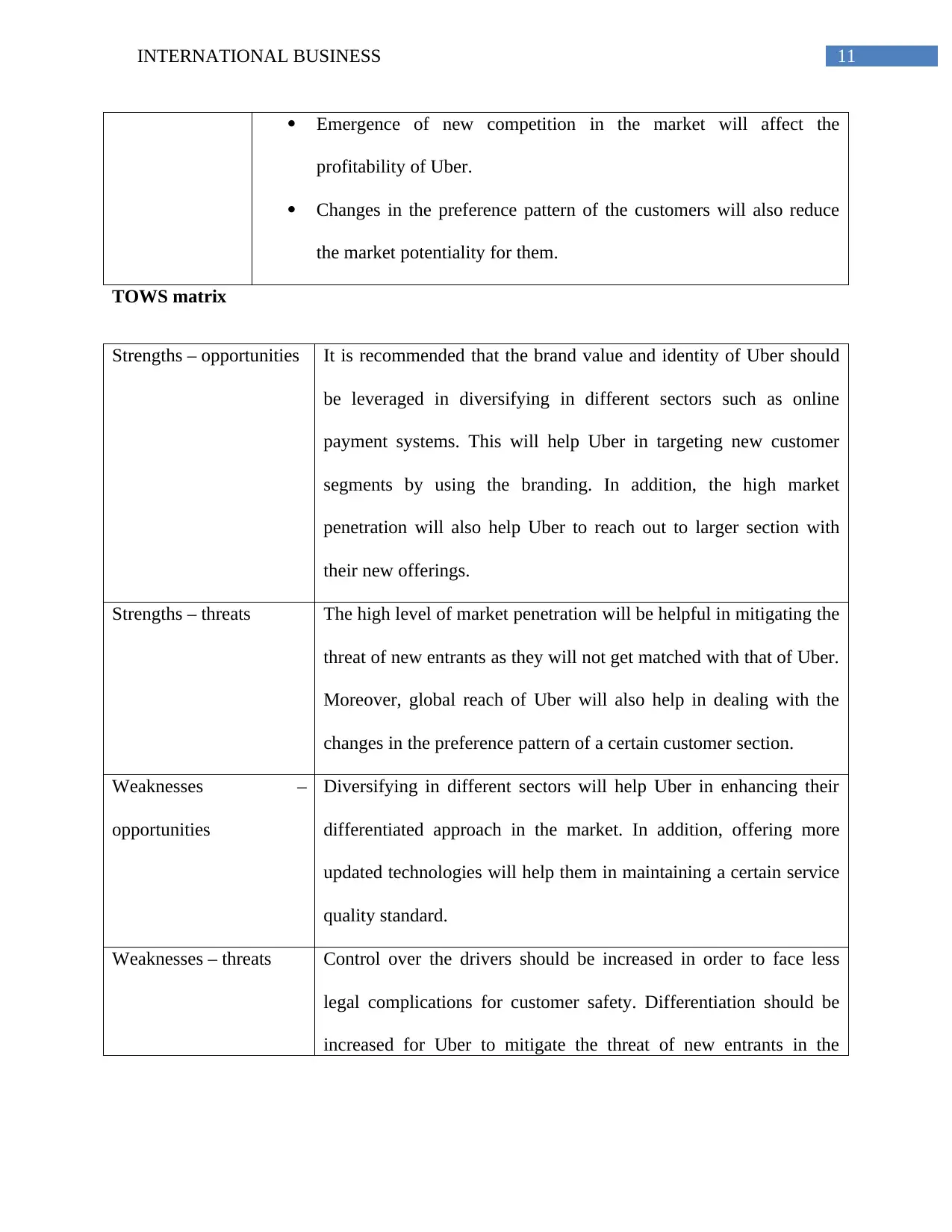
11INTERNATIONAL BUSINESS
Emergence of new competition in the market will affect the
profitability of Uber.
Changes in the preference pattern of the customers will also reduce
the market potentiality for them.
TOWS matrix
Strengths – opportunities It is recommended that the brand value and identity of Uber should
be leveraged in diversifying in different sectors such as online
payment systems. This will help Uber in targeting new customer
segments by using the branding. In addition, the high market
penetration will also help Uber to reach out to larger section with
their new offerings.
Strengths – threats The high level of market penetration will be helpful in mitigating the
threat of new entrants as they will not get matched with that of Uber.
Moreover, global reach of Uber will also help in dealing with the
changes in the preference pattern of a certain customer section.
Weaknesses –
opportunities
Diversifying in different sectors will help Uber in enhancing their
differentiated approach in the market. In addition, offering more
updated technologies will help them in maintaining a certain service
quality standard.
Weaknesses – threats Control over the drivers should be increased in order to face less
legal complications for customer safety. Differentiation should be
increased for Uber to mitigate the threat of new entrants in the
Emergence of new competition in the market will affect the
profitability of Uber.
Changes in the preference pattern of the customers will also reduce
the market potentiality for them.
TOWS matrix
Strengths – opportunities It is recommended that the brand value and identity of Uber should
be leveraged in diversifying in different sectors such as online
payment systems. This will help Uber in targeting new customer
segments by using the branding. In addition, the high market
penetration will also help Uber to reach out to larger section with
their new offerings.
Strengths – threats The high level of market penetration will be helpful in mitigating the
threat of new entrants as they will not get matched with that of Uber.
Moreover, global reach of Uber will also help in dealing with the
changes in the preference pattern of a certain customer section.
Weaknesses –
opportunities
Diversifying in different sectors will help Uber in enhancing their
differentiated approach in the market. In addition, offering more
updated technologies will help them in maintaining a certain service
quality standard.
Weaknesses – threats Control over the drivers should be increased in order to face less
legal complications for customer safety. Differentiation should be
increased for Uber to mitigate the threat of new entrants in the
⊘ This is a preview!⊘
Do you want full access?
Subscribe today to unlock all pages.

Trusted by 1+ million students worldwide
1 out of 19
Related Documents
Your All-in-One AI-Powered Toolkit for Academic Success.
+13062052269
info@desklib.com
Available 24*7 on WhatsApp / Email
![[object Object]](/_next/static/media/star-bottom.7253800d.svg)
Unlock your academic potential
Copyright © 2020–2025 A2Z Services. All Rights Reserved. Developed and managed by ZUCOL.





